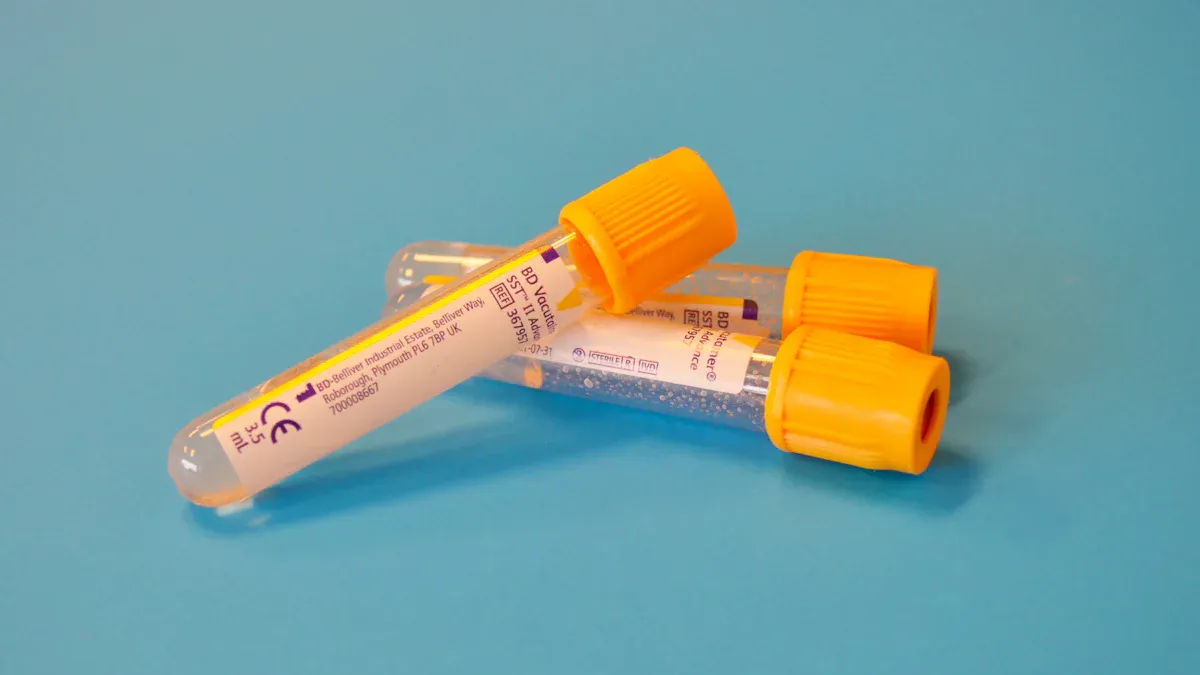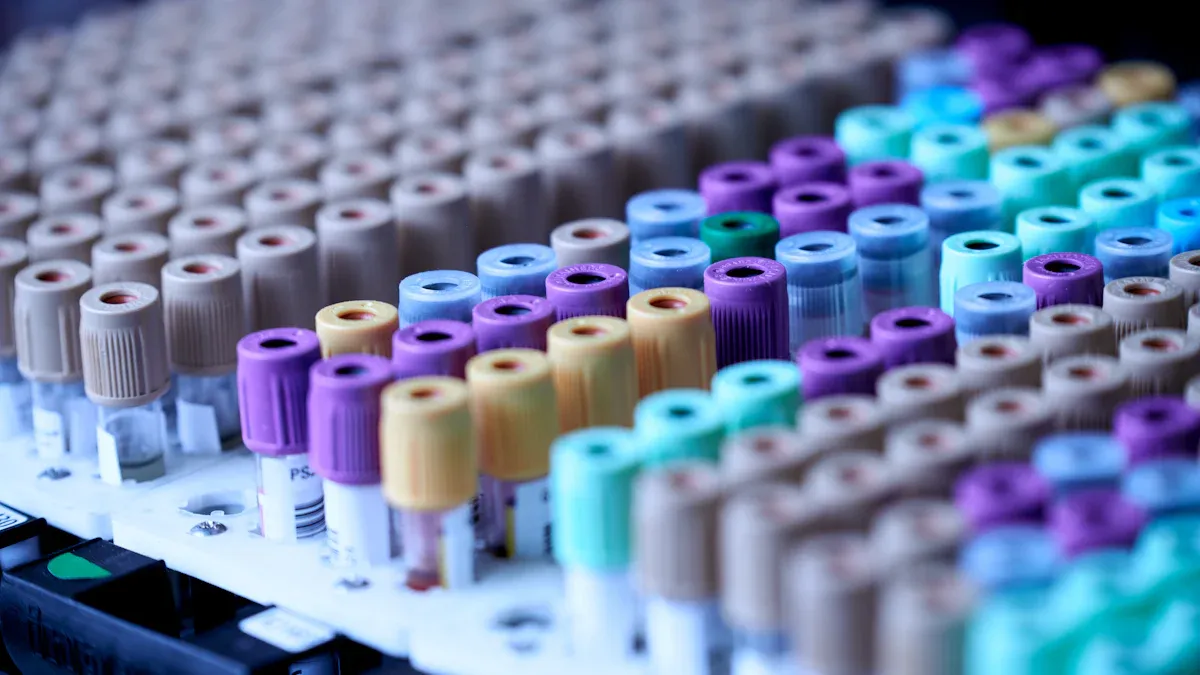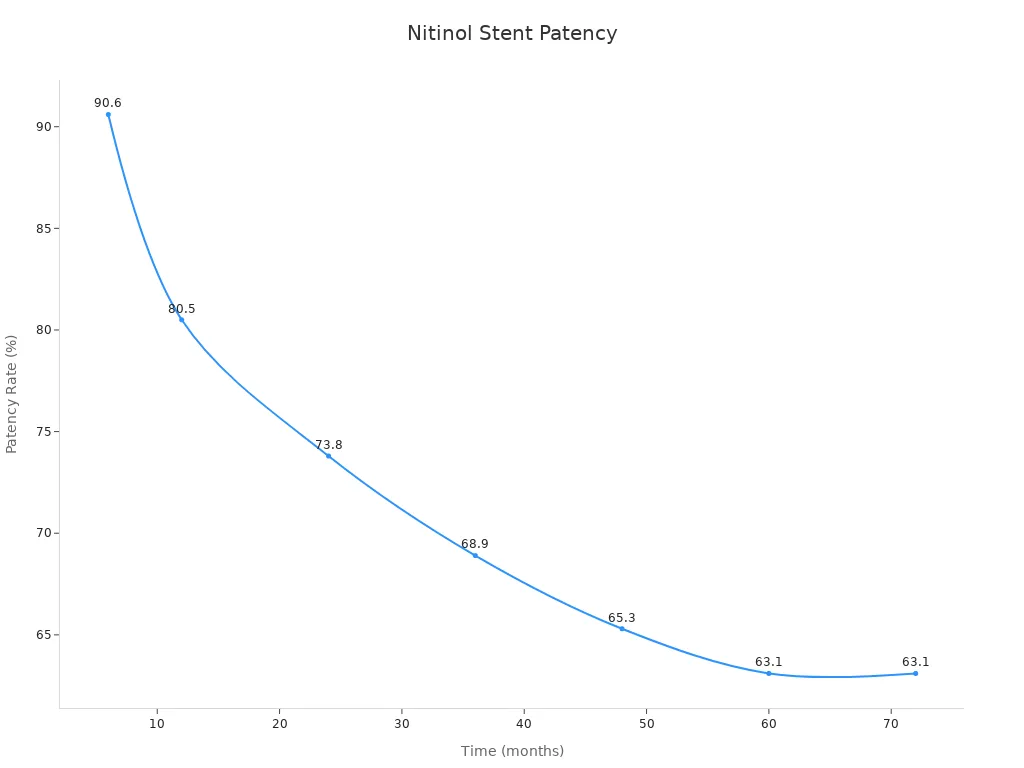What Is Kink-Resistant Nitinol Tubing and Why It Matters in Peripheral Vascular Intervention

Kink resistant nitinol tubing peripheral vascular intervention is crucial in certain surgical procedures. This specialized tubing is designed to bend easily without kinking, which allows doctors to safely navigate complex blood vessels during peripheral vascular intervention. Research demonstrates that kink resistant nitinol tubing peripheral vascular intervention reduces complications such as catheter herniation, making surgeries safer and improving patient outcomes. Devices like interwoven nitinol stents, which utilize kink resistant nitinol tubing, are engineered to mimic the natural behavior of blood vessels. These stents are durable and provide long-lasting support.
The table below highlights key results from surgeries involving kink resistant nitinol tubing peripheral vascular intervention:
Parameter/Metric | Value/Description |
|---|---|
Device Design | Wire-interwoven nitinol stent mimicking native vessel collagen and elastin network |
Stent Composition | 6 closed-end interwoven nitinol wires |
Delivery System | 7 Fr (0.100" minimum), compatible with 0.014" or 0.018" guidewire |
Available Stent Sizes | Lengths: 40, 60, 80, 100, 120, 150 mm; Diameters: 4.0, 5.0, 6.0 mm |
Patient Population | 264 patients with symptomatic peripheral artery disease undergoing femoropopliteal artery treatment |
Primary Patency at 12 Months (Intent-to-Treat) | 78.9% (180/228 patients), statistically significant (P<0.001) |
Primary Patency at 12 Months (Kaplan–Meier) | 86.3% |
Stent Fracture at 12 Months | None observed in 243 stents evaluated by independent core lab |
Clinical Improvement | 88.7% of patients improved by at least 1 Rutherford–Becker category at 12 months |
Safety Outcomes | 99.2% freedom from death, target lesion revascularization, or amputation at 30 days postprocedure |
Significance | Biomimetic design distributes stress evenly, resists kinking and fracture, improves durability and clinical outcomes in peripheral vascular intervention |

Kink resistant nitinol tubing peripheral vascular intervention enhances the safety and reliability of these procedures, providing physicians with advanced tools for minimally invasive treatments.
Key Takeaways
Kink-resistant nitinol tubing bends without breaking. This helps doctors move through tricky blood vessels during surgery. Its superelasticity and shape memory help devices go back to their first shape. This makes them more flexible and less likely to break. Nitinol tubing-based stents keep blood vessels open for a longer time. This helps blood flow better and helps patients heal faster. The tubing is smooth and strong, which lowers problems and keeps patients safer. Studies show nitinol tubing helps patients do better. There are fewer problems and more people stay healthy for a long time.
Nitinol Tubing Basics

What Is Nitinol?
Nitinol tubing is used in many medical devices. It is made from about 55% nickel and 45% titanium. This mix makes nitinol tubing very flexible and strong. Nitinol has a special crystal structure. It can switch between martensite and austenite phases. This helps it work well in medical tools. Nitinol tubing is used for stents, guidewires, and catheters. These are important for minimally invasive surgeries. Nitinol tubing is great for moving through tricky blood vessels. Its flexibility and kink resistance are very important.
Nitinol tubing must be very pure and strong. High-purity nitinol tubing helps stop breaks and device problems. Rules like ASTM F2063 and ISO 10993 make sure nitinol tubing is safe for people.
Specification Aspect | Key Details |
|---|---|
Fatigue Life | Over 10 million cycles without fracture |
Tensile Strength | 500-900 MPa |
Residual Elongation | Shows how well it remembers its shape |
Surface Treatments | Electropolishing helps stop rust |
Compliance Standards | ASTM F2063, ISO 10993 |
Durability Testing | Fast tests for bending and rust |
Superelasticity and Shape Memory
Nitinol tubing is known for superelasticity and shape memory. Superelasticity means it can bend or stretch up to 13%. It goes back to its original shape after bending. This happens because it can change between two crystal forms. In surgeries, nitinol tubing bends as it moves through vessels. It quickly returns to its shape after. Shape memory lets nitinol tubing go back to a set shape when warmed to body temperature. This is important for stents and other devices that need to fit the body.
Tests show nitinol tubing can handle big bends by forming martensite. When the force stops, it changes back to austenite. It gets its shape back. This keeps nitinol tubing flexible and working well, even after many uses.
Kink Resistance
Kink resistance is a key part of nitinol tubing. In surgeries, tubing must bend a lot but not collapse. Nitinol tubing can do this because of its superelastic and shape memory features. It can bend many times without breaking. Studies show nitinol guidewires lower problems by 25% compared to stainless steel. Nitinol tubing’s kink resistance helps doctors move devices safely through the body.
Lab tests show nitinol tubing stays strong and flexible after lots of bending. It keeps its shape even after twisting many times. Electropolishing makes the surface smoother and helps stop cracks. These features make nitinol tubing the best choice for jobs that need lots of bending and strength.
Nitinol tubing is also used outside of blood vessel surgeries. Its special features help in bone implants, braces, and other medical tools.
Kink Resistant Nitinol Tubing Peripheral Vascular Intervention

Navigating Tortuous Vessels
Doctors have trouble moving devices through twisty, narrow blood vessels. Kink resistant nitinol tubing peripheral vascular intervention helps solve this problem. Nitinol tubing can bend and flex without kinking. It works well in very complex blood vessel paths. This flexibility comes from the special properties of nitinol. The tubing can handle sharp turns and curves. This helps doctors reach the right spot during small surgeries.
Tests in pigs show that self-expanding braided nitinol stents fit the vessel’s shape. These stents keep their form and support the vessel wall. They work even in twisty parts of the vessel. In another study, researchers made ultraflexible neural electrode arrays with nitinol tubing. These devices moved through tiny, twisted brain vessels in animals. They caused very little tissue damage. The tubing’s flexibility and strength made safe movement and steady placement possible.
Nitinol tubing also helps doctors see better during procedures. Nitinol catheters and guidewires make fewer problems in MR imaging than ferromagnetic materials. This lets doctors see where the device is more clearly. It makes moving the device safer and more exact. Nitinol tubing can bend and return to its shape. This lowers the risk of device failure. It also makes vessel injury less likely during small surgeries.
Maintaining Lumen Patency
Keeping the blood vessel open is very important in these procedures. Nitinol tubing is a big part of this job. Stents made from nitinol tubing can expand to fit the vessel. They hold the vessel open. The tubing’s superelasticity helps the stent fight outside pressure. It stops the stent from collapsing. This makes sure blood flows well through the treated area.
Tests show nitinol stents work very well. Patients with nitinol stents often have better blood flow. This is measured by the Ankle Brachial Pressure Index. Many patients can walk farther after treatment. Imaging shows nitinol stents keep the vessel open after they are placed. Doctors use special X-rays and markers on nitinol tubing to put stents in the right spot.
Nitinol tubing’s kink resistance helps stop restenosis, which is when the vessel gets narrow again. The tubing spreads stress evenly along the vessel wall. This lowers the chance of damage and helps the vessel stay healthy. Reviews and trials support using nitinol tubing to keep vessels open. These studies show nitinol stents work as well or better than other types in small surgeries.
Device Control and Safety
Doctors need to control their devices very well during small surgeries. Kink resistant nitinol tubing peripheral vascular intervention gives them this control. Nitinol tubing reacts fast to the doctor’s movements. It bends and straightens but stays strong. This helps doctors guide catheters and guidewires through tough spots.
Nitinol tubing also makes procedures safer. Its kink resistance stops sudden collapses or blockages that could hurt the patient. The tubing’s smooth surface, made smoother by electropolishing, lowers friction as it moves. This makes vessel injury less likely and helps the device move forward.
Guidewires made from nitinol tubing give great torque control. Doctors can steer these guidewires through tight spaces easily. Catheters with nitinol tubing keep their shape and work well, even after many bends. Stents with nitinol tubing do not break and stay in place over time. These features help patients have better results after small surgeries.
Nitinol tubing works well in guidewires, catheters, and stents. Its flexibility, strength, and kink resistance make it the best choice for many small surgeries. Doctors trust nitinol tubing to give safe, effective, and steady results in peripheral vascular interventions.
Nitinol Tubing for Peripheral Stents
Self-Expanding Stents
Nitinol tubing has changed how doctors treat blood vessels. Self-expanding stents made with nitinol tubing can move with the vessel. They help keep blood flowing well. Nitinol’s superelasticity lets these stents bounce back after being squeezed. This helps the stent fit the vessel wall and lowers tissue harm. Clinical trials show patency rates can reach 90.7% at 12 months. No stent fractures were found in these studies. Most patients feel much better after getting nitinol tubing stents. These stents pass tough tests that copy ten years of use. This proves they are strong and last a long time.
Metric | Result |
|---|---|
Primary Patency Rate | Up to 90.7% at 12 months |
Stent Fracture Rate | 0% at 12 months |
Clinical Improvement | 88.7% improved by ≥1 Rutherford–Becker category |
Durability | 10 years simulated use, no fractures |

Interwoven and Braided Designs
Engineers use nitinol tubing to make braided and interwoven stents. These stents are more flexible and fit vessels better. Computer tests show braided nitinol stents open smoothly and touch vessel walls well. Nitinol tubing is used in stents that act like real blood vessels. Braided stents have connectors that stop wires from sliding but let them twist. This makes the stents stronger and less likely to break. Nitinol tubing helps stents move through tricky vessels and lowers surgery risks.
Long-Term Patency
Nitinol tubing helps stents stay open for a long time. Studies say patency rates are over 80% after one year. More than 63% of stents stay open after five years. New nitinol stents have thin parts and special coatings. These lower swelling and help healing go faster. Peripheral stents keep vessels open and stop problems. Nitinol tubing does not rust, so stents last longer. These things make nitinol tubing a top pick for many vessel surgeries.
Follow-up (years) | Primary Patency Rate (%) | Secondary Patency Rate (%) |
|---|---|---|
1 | 79.8 | 90.4 |
3 | 66.7 | 87.3 |
5 | 63.1 | 86.2 |

Nitinol vs. Other Vascular Materials
Stainless Steel and Polymers
Nitinol is different from other materials used in blood vessel implants. Stainless steel and polymers are common choices for stents and devices. Stainless steel is strong but does not bend or resist kinks like nitinol. Polymers are light and safe for the body, but they do not last as long. Nitinol has special features like superelasticity and shape memory. These help it work well in self-expanding stents and other implants. Nitinol devices can move with the vessel and keep their shape for a long time.
Study Focus | Comparison Groups | Clinical Outcomes Assessed | Key Findings |
|---|---|---|---|
ARMADILLO Study (2024) | Viabahn covered stent-grafts (non-nitinol) vs. Supera interwoven nitinol stents | Patency, restenosis rates in severely calcified femoropopliteal artery disease | Differences in clinical outcomes linked to stent design and material properties; nitinol stents showed distinct performance compared to covered stent-grafts |
Flexibility and Kink Resistance
Nitinol’s superelasticity makes it very flexible and hard to kink. It can bend and go back to its shape, even after many bends. Stainless steel and polymers cannot do this as well. Nitinol stents can be squeezed small for delivery. They then expand to fit the vessel just right. Shape memory helps nitinol stents stay in place and adjust as needed. Tests show nitinol can handle stress without breaking. Nitinol devices stay strong and flexible, even after lots of use. Rules like ISO9001:2015 and ISO13485:2016 make sure nitinol implants are made well.
Nitinol drive wires and stents last longer and are stronger. This makes them a top pick for tough blood vessel surgeries.
Clinical Outcomes
Studies show nitinol works better than other materials. The ORION Trial found nitinol devices help patients heal faster and feel less pain. These implants also lower the chance of problems and help people get better results. Nitinol is safe for the body and does not rust. Patients get smaller cuts, less scarring, and heal quicker. The XLPAD Registry Study showed Supera interwoven nitinol stents kept vessels open better than other stents. Nitinol’s strength helps it work well for a long time in blood vessel implants.
Metric / Trial Aspect | Nitinol Devices / EPIC™ Nitinol Stent System | Traditional Materials / Comparator |
|---|---|---|
Recovery Improvement | Approximately 20% faster recovery | N/A |
Pain Level Reduction | Quicker recovery and reduced pain levels | N/A |
Risk of Complications | Lower risk of complications | N/A |
Patient Enrollment (ORION Trial) | 123 patients at 25 sites | N/A |
Major Adverse Events (MAE) | Evaluated at 9 months, confirming safety | N/A |
Duration of Study (ORION Trial) | 9 months | N/A |
Kink-resistant nitinol tubing is very important in small surgeries. Its superelasticity and shape memory help devices move through twisty vessels. The tubing does not kink or fold. Special surface treatments make it safer and last longer. Studies show people do better and have a lower chance of dying when doctors use nitinol tubing. Patients get better faster and have fewer problems after surgery. The tubing is strong and bends easily, so doctors can use it many times. Picking the right material helps patients get the best results from small surgeries.
Clinical Study | Outcome with Nitinol Tubing | Outcome with Standard Care |
|---|---|---|
DAWN Trial | 49% functional independence | 13% functional independence |
PARTNER 3 Trial | 1.0% mortality rate | 2.5% mortality rate |
Small surgeries with nitinol tubing work well and are safe.
The tubing bends and keeps its shape, so doctors can move it safely.
Following rules makes sure these surgeries are safe and work well.
People do better in the long run when doctors use nitinol tubing in small surgeries.
FAQ
What makes nitinol tubing kink-resistant?
Nitinol tubing is made from a nickel-titanium alloy. This alloy lets the tubing bend a lot. It can go back to its shape after bending. These features stop the tubing from kinking.
Where do doctors use kink-resistant nitinol tubing?
Doctors use this tubing in guidewires, catheters, and stents. These tools help fix blocked or narrow blood vessels. They are used in the legs, arms, and other body parts.
How does nitinol tubing improve patient safety?
Nitinol tubing bends without kinking or breaking. This helps stop device problems or vessel injuries. Patients have fewer issues and heal faster after surgery.
Is nitinol tubing safe for the human body?
Medical-grade nitinol tubing follows strict safety rules like ASTM F2063 and ISO 10993. These rules make sure the tubing is safe to use inside the body.
See Also
The Importance Of Nitinol Tubing In Minimally Invasive Surgery
Nitinol Tubing’s Critical Role In Cutting Edge Medical Uses
How Nitinol Tubing Drives Progress In Medical Technology
Ways Nitinol Tubing Is Transforming Modern Medical Devices
The Process Behind Manufacturing Nitinol Tubing For Medicine

